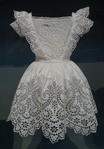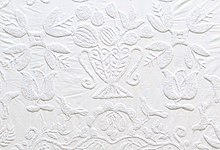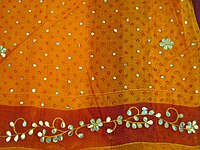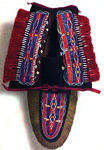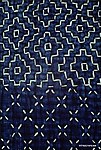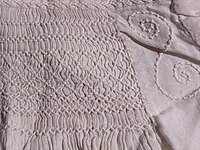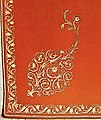Embroidery is the art of decorating fabric or other materials using a needle to stitch thread or yarn. Embroidery may also incorporate other materials such as pearls, beads, quills, and sequins. In modern days, embroidery is usually seen on hats, clothing, blankets, and handbags. Embroidery is available in a wide variety of thread or yarn colour. It is often used to personalize gifts or clothing items.


Some of the basic techniques or stitches of the earliest embroidery are chain stitch, buttonhole or blanket stitch, running stitch, satin stitch, and cross stitch.[1] Those stitches remain the fundamental techniques of hand embroidery today.
History edit

Origins edit
The process used to tailor, patch, mend and reinforce cloth fostered the development of sewing techniques, and the decorative possibilities of sewing led to the art of embroidery.[2] Indeed, the remarkable stability of basic embroidery stitches has been noted:
It is a striking fact that in the development of embroidery ... there are no changes of materials or techniques which can be felt or interpreted as advances from a primitive to a later, more refined stage. On the other hand, we often find in early works a technical accomplishment and high standard of craftsmanship rarely attained in later times.[3]
The art of embroidery has been found worldwide and several early examples have been found. Works in China have been dated to the Warring States period (5th–3rd century BC).[4] In a garment from Migration period Sweden, roughly 300–700 AD, the edges of bands of trimming are reinforced with running stitch, back stitch, stem stitch, tailor's buttonhole stitch, and Whip stitch, but it is uncertain whether this work simply reinforced the seams or should be interpreted as decorative embroidery.[5]
Historical applications and techniques edit



Depending on time, location and materials available, embroidery could be the domain of a few experts or a widespread, popular technique. This flexibility led to a variety of works, from the royal to the mundane. Examples of high status items include elaborately embroidered clothing, religious objects, and household items often were seen as a mark of wealth and status.
In medieval England, Opus Anglicanum, a technique used by professional workshops and guilds in medieval England,[6] was used to embellish textiles used in church rituals. In 16th century England, some books, usually bibles or other religious texts, had embroidered bindings. The Bodleian Library in Oxford contains one presented to Queen Elizabeth I in 1583. It also owns a copy of The Epistles of Saint Paul, whose cover was reputedly embroidered by the Queen.[7]
In 18th-century England and its colonies, with the rise of the merchant class and the wider availability of luxury materials, rich embroideries began to appear in a secular context. These embroideries took the form of items displayed in private homes of well-to-do citizens, as opposed to a church or royal setting. Even so, the embroideries themselves may still have had religious themes. Samplers employing fine silks were produced by the daughters of wealthy families. Embroidery was a skill marking a girl's path into womanhood as well as conveying rank and social standing.[8]
Embroidery was an important art and signified social status in the Medieval Islamic world as well. The 17th-century Turkish traveler Evliya Çelebi called it the "craft of the two hands". In cities such as Damascus, Cairo and Istanbul, embroidery was visible on handkerchiefs, uniforms, flags, calligraphy, shoes, robes, tunics, horse trappings, slippers, sheaths, pouches, covers, and even on leather belts. Craftsmen embroidered items with gold and silver thread. Embroidery cottage industries, some employing over 800 people, grew to supply these items.[9]
In the 16th century, in the reign of the Mughal Emperor Akbar, his chronicler Abu al-Fazl ibn Mubarak wrote in the famous Ain-i-Akbari:
"His majesty [Akbar] pays much attention to various stuffs; hence Irani, Ottoman, and Mongolian articles of wear are in much abundance especially textiles embroidered in the patterns of Nakshi, Saadi, Chikhan, Ari, Zardozi, Wastli, Gota and Kohra. The imperial workshops in the towns of Lahore, Agra, Fatehpur and Ahmedabad turn out many masterpieces of workmanship in fabrics, and the figures and patterns, knots and variety of fashions which now prevail astonish even the most experienced travelers. Taste for fine material has since become general, and the drapery of embroidered fabrics used at feasts surpasses every description."[10]
Conversely, embroidery is also a folk art, using materials that were accessible to nonprofessionals. Examples include Hardanger embroidery from Norway; Merezhka from Ukraine; Mountmellick embroidery from Ireland; Nakshi kantha from Bangladesh and West Bengal; Achachi from Peru; and Brazilian embroidery. Many techniques had a practical use such as Sashiko from Japan, which was used as a way to reinforce clothing.[11][12]
While historically viewed as a pastime, activity, or hobby, intended just for women, embroidery has often been used as a form of biography. Women who were unable to access a formal education or, at times, writing implements, were often taught embroidery and utilized it as a means of documenting their lives by telling stories through their embroidery.[13] In terms of documenting the histories of marginalized groups, especially women of color both within the United States and around the world, embroidery is a means of studying the everyday lives of those whose lives largely went unstudied throughout much of history.[14]
21st century edit


Since the late 2010s, there has been a growth in the popularity of embroidering by hand. As a result of visual social media such as Pinterest and Instagram, artists are able to share their work more extensively, which has inspired younger generations to pick up needle and threads.[citation needed]
Contemporary embroidery artists believe hand embroidery has grown in popularity as a result of an increasing need for relaxation and digitally disconnecting practices.[15]
Modern hand embroidery, as opposed to cross-stitching, is characterized by a more "liberal" approach, where stitches are more freely combined in unconventional ways to create various textures and designs.[citation needed]
Classification edit
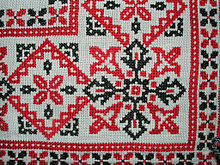
Embroidery can be classified according to what degree the design takes into account the nature of the base material and by the relationship of stitch placement to the fabric. The main categories are free or surface embroidery, counted-thread embroidery, and needlepoint or canvas work.[16]
In free or surface embroidery, designs are applied without regard to the weave of the underlying fabric. Examples include crewel and traditional Chinese and Japanese embroidery.
Counted-thread embroidery patterns are created by making stitches over a predetermined number of threads in the foundation fabric. Counted-thread embroidery is more easily worked on an even-weave foundation fabric such as embroidery canvas, aida cloth, or specially woven cotton and linen fabrics. Examples include cross-stitch and some forms of blackwork embroidery.
While similar to counted thread in regards to technique, in canvas work or needlepoint, threads are stitched through a fabric mesh to create a dense pattern that completely covers the foundation fabric.[17] Examples of canvas work include bargello and Berlin wool work.
Embroidery can also be classified by the similarity of its appearance. In drawn thread work and cutwork, the foundation fabric is deformed or cut away to create holes that are then embellished with embroidery, often with thread in the same color as the foundation fabric. When created with white thread on white linen or cotton, this work is collectively referred to as whitework.[18] However, whitework can either be counted or free. Hardanger embroidery is a counted embroidery and the designs are often geometric.[19] Conversely, styles such as Broderie anglaise are similar to free embroidery, with floral or abstract designs that are not dependent on the weave of the fabric.[20]
Traditional hand embroidery around the world edit
Materials edit

A needle is the main stitching tool in embroidery, and comes in various sizes and types.[28] The fabrics and yarns used in traditional embroidery vary from place to place. Wool, linen, and silk have been in use for thousands of years for both fabric and yarn. Today, embroidery thread is manufactured in cotton, rayon, and novelty yarns as well as in traditional wool, linen, and silk. Ribbon embroidery uses narrow ribbon in silk or silk/organza blend ribbon, most commonly to create floral motifs.[29]
Surface embroidery techniques such as chain stitch and couching or laid-work are the most economical of expensive yarns; couching is generally used for goldwork. Canvas work techniques, in which large amounts of yarn are buried on the back of the work, use more materials but provide a sturdier and more substantial finished textile.[30]
In both canvas work and surface embroidery an embroidery hoop or frame can be used to stretch the material and ensure even stitching tension that prevents pattern distortion.[31] Modern canvas work tends to follow symmetrical counted stitching patterns with designs emerging from the repetition of one or just a few similar stitches in a variety of hues. In contrast, many forms of surface embroidery make use of a wide range of stitching patterns in a single piece of work.[32]
Machine embroidery edit

The development of machine embroidery and its mass production came about in stages during the Industrial Revolution. The first embroidery machine was the hand embroidery machine, invented in France in 1832 by Josué Heilmann.[33] The next evolutionary step was the schiffli embroidery machine. The latter borrowed from the sewing machine and the Jacquard loom to fully automate its operation. The manufacture of machine-made embroideries in St. Gallen in eastern Switzerland flourished in the latter half of the 19th century.[34] Both St. Gallen, Switzerland and Plauen, Germany were important centers for machine embroidery and embroidery machine development. Many Swiss and Germans immigrated to Hudson county, New Jersey in the early twentieth century and developed a machine embroidery industry there. Shiffli machines have continued to evolve and are still used for industrial scale embroidery.[35]

Contemporary embroidery is stitched with a computerized embroidery machine using patterns digitized with embroidery software. In machine embroidery, different types of "fills" add texture and design to the finished work. Machine embroidery is used to add logos and monograms to business shirts or jackets, gifts, and team apparel as well as to decorate household linens, draperies, and decorator fabrics that mimic the elaborate hand embroidery of the past.
Machine embroidery is most typically done with rayon thread, although polyester thread can also be used. Cotton thread, on the other hand, is prone to breaking and is avoided.[36]
There has also been a development in free hand machine embroidery, new machines have been designed that allow for the user to create free-motion embroidery which has its place in textile arts, quilting, dressmaking, home furnishings and more. Users can use the embroidery software to digitize the digital embroidery designs. These digitized design are then transferred to the embroidery machine with the help of a flash drive and then the embroidery machine embroiders the selected design onto the fabric.
In literature edit
In Greek mythology the goddess Athena is said to have passed down the art of embroidery (along with weaving) to humans, leading to the famed competition between herself and the mortal Arachne.[37]
Gallery edit
- Traditional embroidery in chain stitch on a Kazakh rug, contemporary.
- Caucasian embroidery
- English cope, late 15th or early 16th century. Silk velvet embroidered with silk and gold threads, closely laid and couched. Contemporary Art Institute of Chicago textile collection.
- Extremely fine underlay of St. Gallen Embroidery
- Traditional Turkish embroidery. Izmir Ethnography Museum, Turkey.
- Traditional Croatian embroidery.
- Gold embroidery on a gognots (apron) of a 19th-century Armenian bridal dress from Akhaltsikhe
- Brightly coloured Korean embroidery.
- Uzbekistan embroidery on a traditional women's parandja robe.
- Woman wearing a traditional embroidered Kalash headdress, Pakistan.
- Bookmark of black fabric with multicolored Bedouin embroidery and tassel of embroidery floss
- Chain-stitch embroidery from England c. 1775
- Traditional Bulgarian Floral embroidery from Sofia and Trun.
- A 1919 painting depicting the Brazilian flag being embroidered by a family.
See also edit
Notes edit
Citations edit
Bibliography edit
- Gillow, John; Sentance, Bryan (1999). World Textiles. Bulfinch Press/Little, Brown. ISBN 0-8212-2621-5.
- Levey, S. M.; King, D. (1993). The Victoria and Albert Museum's Textile Collection Vol. 3: Embroidery in Britain from 1200 to 1750. Victoria and Albert Museum. ISBN 1-85177-126-3.
- Netherton, Robin; Owen-Crocker, Gale R., eds. (2005). Medieval Clothing and Textiles, Volume 1. Boydell Press. ISBN 1-84383-123-6.
- Complete Guide to Needlework. Reader's Digest. 1979. ISBN 0-89577-059-8.
- van Niekerk, Di (2006). A Perfect World in Ribbon Embroidery and Stumpwork. Search Press. ISBN 1-84448-231-6.
Further reading edit
- Berman, Pat (2000). "Berlin Work". American Needlepoint Guild. Archived from the original on 2009-02-06. Retrieved 2009-01-24.
- Caulfeild, S.F.A.; B.C. Saward (1885). The Dictionary of Needlework.
- Crummy, Andrew (2010). The Prestonpans Tapestry 1745. Burke's Peerage & Gentry, for Battle of Prestonpans (1745) Heritage Trust.
- Embroiderers' Guild Practical Study Group (1984). Needlework School. QED Publishers. ISBN 0-89009-785-2.
- Koll, Juby Aleyas (2019). Sarah's Hand Embroidery Tutorials.
- Lemon, Jane (2004). Metal Thread Embroidery. Sterling. ISBN 0-7134-8926-X.
- Vogelsang, Gillian; Vogelsang, Willem, eds. (2015). TRC Needles. The TRC Digital Encyclopaedia of Decorative Needlework. Leiden, The Netherlands: Textile Research Centre.
- Wilson, David M. (1985). The Bayeux Tapestry. Thames and Hudson. ISBN 0-500-25122-3.
External links edit
 Media related to Embroidery at Wikimedia Commons
Media related to Embroidery at Wikimedia Commons

- The History of Embroidery







